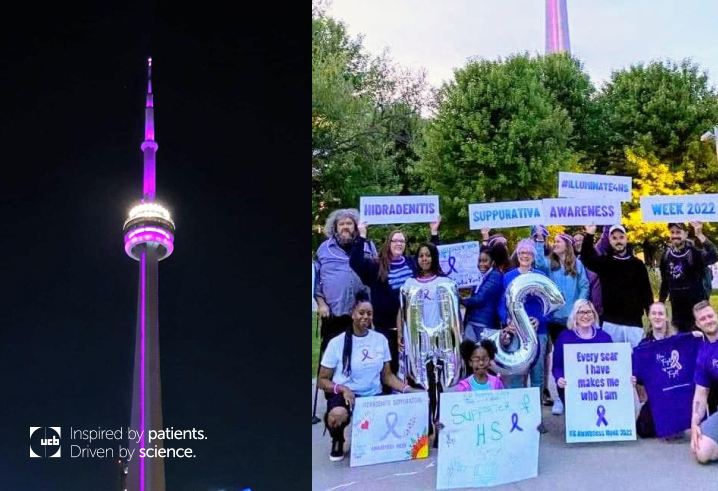Building Awareness and Hope for Patients with HS: A conversation with Dr. Hélène Veillette

Hidradenitis suppurativa (HS), a chronic and often debilitating inflammatory skin disease, affects up to a million people in Canada, but delayed diagnosis and stigma often leave patients suffering in silence for years. Characterized by inflamed, painful masses forming protrusions under the skin, often in sensitive areas like armpits, groin, and buttocks, HS can have a significant negative impact on quality of life.1,2
Reducing stigma and building understanding are keys to increasing rates of diagnosis, and ultimately, creating better quality of life. As a company committed to advancing care and driving enhanced patient outcomes, UCB strives to uplift voices of key groups and opinion leaders on the forefront of chronic disease awareness efforts for HS.
Organizations like Hidradenitis & Me Support Group and Canadian Skin Patient Association (CSPA) help connect people with resources and community on their journey with the disease. During HS Awareness Week 2025, Hidradenitis & Me is lighting up monuments across Canada in purple to spread visibility.
Healthcare providers can be another key source of support for patients with HS. To increase awareness of how HS impacts patients, the importance of diagnosis, and a positive outlook for the future, UCB spoke with dermatologist Dr. Hélène Veillette, who shared her expertise with us.
UCB: Can you share a little about how HS impacts patients’ quality of life, and why timely diagnosis is so important?
HV: Generally, HS impacts people’s quality of life more than other skin conditions. In Canada, people with HS will see an average of five doctors and have more than 17 medical appointments over eight years before being diagnosed.3 HS is associated with very painful symptoms, deep lesions (nodules or abscesses) giving off an unpleasant smell and discharging pus. Over time, lesions may form clusters and turn into residual scars. Often people with HS may have it for years before receiving effective treatment. Because of this, they experience frustration, powerlessness, and shame caused by this disease.
UCB: Are there any common myths or misconceptions about HS that can impact diagnosis?
HV: First, the initial diagnosis is often wrong. People think they have ingrown hair or a skin infection. We often hear people say casually that they have blisters or boils. Another myth is that nothing can be done to treat this disease. We are learning more and more about HS, and we have treatments that can be effective.
UCB: Can you speak more about how medical care can improve quality of life for HS patients?
HV: When HS is well controlled, patients feel they are regaining control of their lives. For example, if treatment makes the disease less active, there will probably be less pain. Patients regain a life where they are sleeping better and are more able to engage in physical activity, and symptoms of depression and anxiety finally decrease. Personal and professional relationships are easier. Some patients also say the costs of bandages are a problem and, once they have been treated, it’s a big relief to see their bandage bill go down.
UCB: What are some of the most common anxieties or concerns expressed to you by patients with HS?
HV: Some patients are afraid no effective treatment will be found for them. Some worry about the potential side effects of treatments. Fortunately, I can usually reassure that with appropriate monitoring, we end up finding a treatment, or a combination of treatments, that works and is well tolerated. We have several possible treatments, and in the coming years, the arrival of new approved treatments should help us to better treat patients for whom current treatments are not adequate.
UCB: What advice would you give to someone newly diagnosed with HS?
HV: Firstly, getting diagnosed is great news because that’s the starting point for getting proper care. Most frontline doctors will know how to manage initial HS. If your disease is more severe, you need a dermatology consultation. The internet is full of good (and not so good) information about HS. Make sure you consult reliable websites, such as the Canadian HS Foundation. Patient groups may also be a valuable resource, such as Hidradenitis & Me.
UCB: Do you have any other comments you would like to add?
HV: There is a lot of hope for patients with HS. Research has made a lot of progress since the early years. It’s important to have an open discussion with the healthcare professionals taking care of you. Talk to them about what you are worried about and the symptoms that are most affecting your life. That will help the care team have a clear understanding of your situation and adapt your care to your situation. Every HS patient is unique! Don’t lose hope.
REFERENCES
1. https://dermatology.ca/public-patients/diseases-conditions/skin-conditions/hidradenitis-suppurativa/
2. UCB. Hidradenitis Suppurativa. https://www.ucb.com/solutions/diseases/hidradenitis-suppurativa.
3. https://www.canadianskin.ca/images/Documents/CSPA_Report_March_22_2017_website_final.pdf
